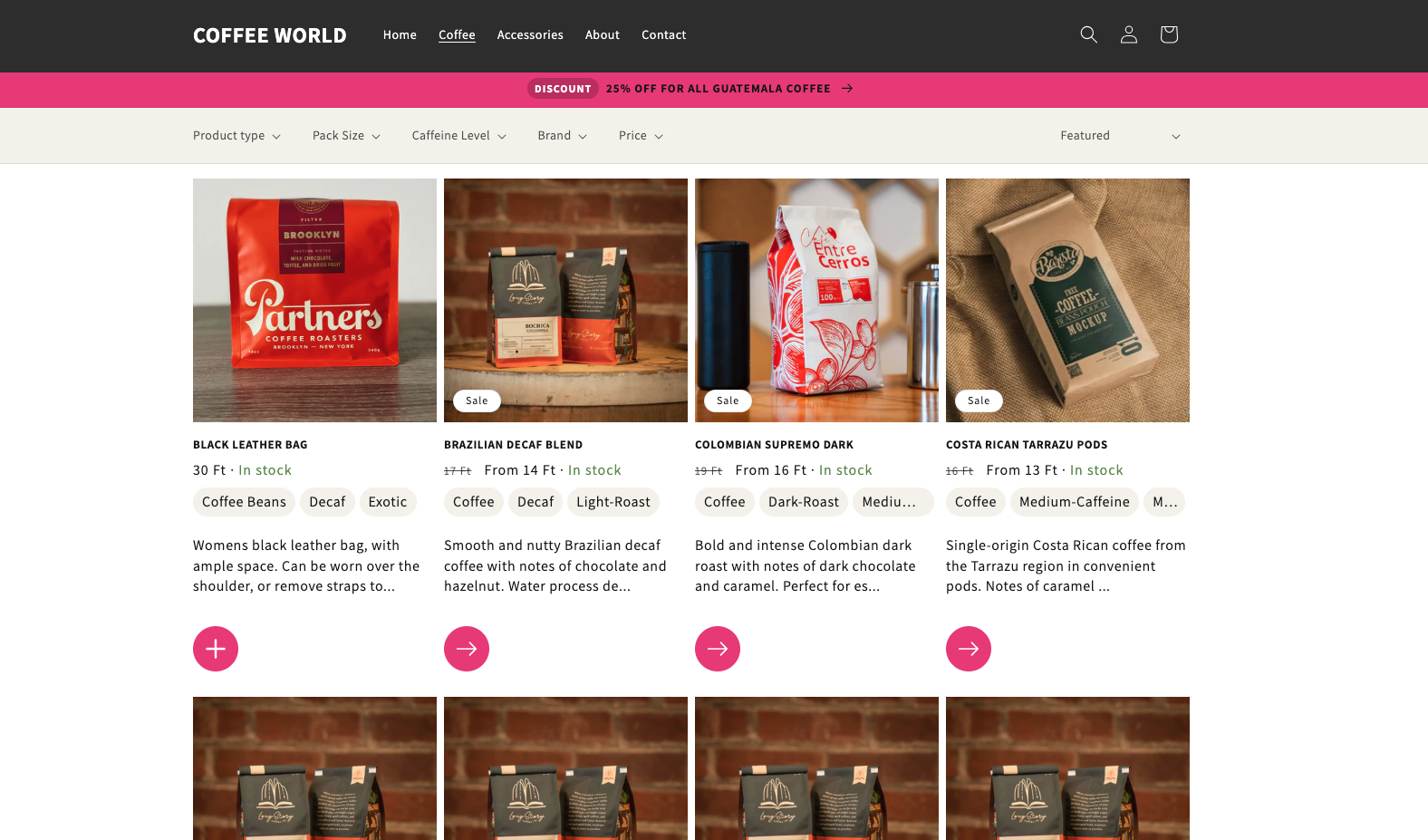Week #4: How to focus?

I have been actively writing short form (Bluesky, Facebook and LinkedIn) and long form (gaborify.com) for 4 weeks! 🎉
I am very happy with this consistency. Not because my audience is growing like mushroom, but because I have a plan and I'm sticking to it. I am showing up and I am forcing myself to think, to show my work and I increase my luck surface every day, even if just a little bit.
However, I am not completely happy with my results. It's been a month since I embarked on my Shopify journey, and I still haven't published my first theme.
Let's see why not, whether it is a problem and what can I do about it.
Page designs behind and ahead of me
This week I have created the following pages of my theme:
- Collection page
- About page
- Product page



Three pages doesn't sound bad, but there is still some pages and tasks left to do:
- Cart page
- Checkout page
- A simple page (for Terms for example)
- Mobile layout fixes
- Adding translations
- Anything unexpected
It's time to fail fast
The issue of course is that I am doing three things at a time: learning, solving problems and designing.
Learning and solving problems take a huge amount of time at this point, because everything in the Shopify ecosystem is new to me. Hopefully this part of development will speed up along the way.
Designing on the other hand is just simply necessary, because obviously I'd like to produce something valuable.
I try to avoid being a perfectionist. I remind myself that the goal is not to make profit at this point, but to learn about Shopify, Envato, gain momentum, and most importantly, to build a portfolio.
I am really aiming for submitting next week. It's fine if the review process will not end by the end of next week, but I'd like to get my first submission done.
New challenge ahead: Envato Theme Previews
While I was reading about the Envato Marketplace I have stumbled upon a challenge: theme previews.
Envato requires you to provide a real Shopify experience for your previews. This means a real Shopify store.
However, Shopify protects your store with a password on your free plan. To remove the password you need to subscribe to paid plan... PER STORE.
Now, if you want to create multiple themes, as I do, this is of course unsustainable.
What you can do however (and I am planning to) is to create Preview Links provided by Shopify. This way you can have one-and-only store, with multiple themes available on them. Your site is always visible with one, published theme, but you can generate preview links for the other themes too.
You can create these links manually, but the issue is, these links expire after a couple of days. Updating the links in Envato every couple of days is of course out of the question.
Shopify API + Firebase
Luckily, we can use the Shopify API to generate these links programatically.
So my master plan is to spin up a Firebase Function with a public URL that will serve as the theme preview URL. This function will use the Shopify API to request a preview url, store it in Firebase Firestore, and ask a new one if the previous one expires.
How to focus
The non-technical skill I am trying to sharpen is to focus. Focus is the drive of your productivity. Focus can make your time more valuable, by making you getting done more in less time.
Let's see the tricks I am implementing.
🧑⚕️ Diagnosis
Treatment needs to be preceded by diagnosis.
I know I am struggling to focus when I open up Bluesky and Facebook just to get some stimulus. My brain is looking for instant gratification in the form of notifications, messages and other interactions.
Another, less recognizable pattern is jumping between tasks. When I work on my theme I sometimes find myself jumping between pages, looking at the Homepage for example, even when it's not related to my current task. When I write, sometimes I scroll up and down to read my introduction or my drafts.
These are substitute activitues that block my focus. These cries for entertainment are in the way of deep work. In order to eliminate them, first I need to recognize them, so I can come up with tactics to tackle them.
🧑🎓 Learning the skill to focus
The first tactic is to train my focus muscle. Just like certain muscles in your arms can be trained, "muscles" in your brain can be trained too. This applies for example to creativity, memory, and logical thinking.
To learn to focus, we can train by practicing defocusing in the form of meditation. Meditation is about learning how to let go of your thoughts, which apparently activates the same part of your brain as strongly sticking to one thought.
I have built meditation into my morning routine. I meditate 10 minutes before I start to work, using a free app called Smiling Mind. So far I'm enjoying it.
🎨 Designing environment
The second tactic is to design my environment to be less distractive and more focused. This included the following adjustments:
- Blocking social media sites using FocusGuard Chrome extension
- Deleting social media apps with feeds from my phone
- Putting up a whiteboard on my wall (next to my monitor) with my big picture goal and small tasks to achieve it
- Moving my bookshelf behind my desk, instead of having it next to it. I love my books but they get me distracted. Same with photos of friends and family.
☀️ Clarity
Constant reminders of your values and goals can be a huge motivator factor. That's why I wrote my main goal on my whiteboard so I can read it every day.
"Escape corporate"
Everytime I get distracted I remind myself that by fooling around this reality gets a little bit further away.
🌊 Less friction
The less friction we have and the less decisions we need to make a day, the more streamlined we can work.
A tiny adjustment was to pack away my Mac Mini and pull up my old MacBook Pro instead. My Mac Mini is faster than my old laptop, but the laptop provices mobility, so I don't have to rely on my 9-5 company laptop to work away from home. I also ditched some of the apps, sticking to only the essentials.
🍅 Time tracking
I still track my time using Focus To Do app. This app rings a bell every 25 minutes, reminding myself to reevaluate, whether I am working on the right task.
This pomodoro technique works so well, that I even estimate my mornings in pomodoros. I know that, I can only fit 2 or 3 pomodoros into my mornings, so I really have to choose well, which tasks I start working on.
🔋 Deliberate recharging
I finally managed to actually practice slow productivity, which is the key to consistency. I do not try to fit in a little bit of work every time I have a few minutes.
I achieved this by setting up a routine and by conditioning my brain to think in blocks instead of "amount of work per day".
Mornings are for my side-hustle. Weekdays are for my 9-5. Evenings and weekends are for friends and family.
I also run in a more structured way. I am following a plan in the Nike Running Club app so I don't have to think much about it. I am working towards a goal: to run my 2nd half-marathon. This hobby is so different to my everyday work, that it provides a great rhythm to my life.
I do have the urge to work more. Sometimes it's hard to resist. But I am also experienced enough to know, that grabbing a book to read at 9pm will recharge me whereas working a little bit more will burn me out, especially on the long run.
Focus is the skill you need
I am really sold on the idea, that focus is one of the main pillars of success. I am planning on researching more on the subject, especially on the psychological side of it.